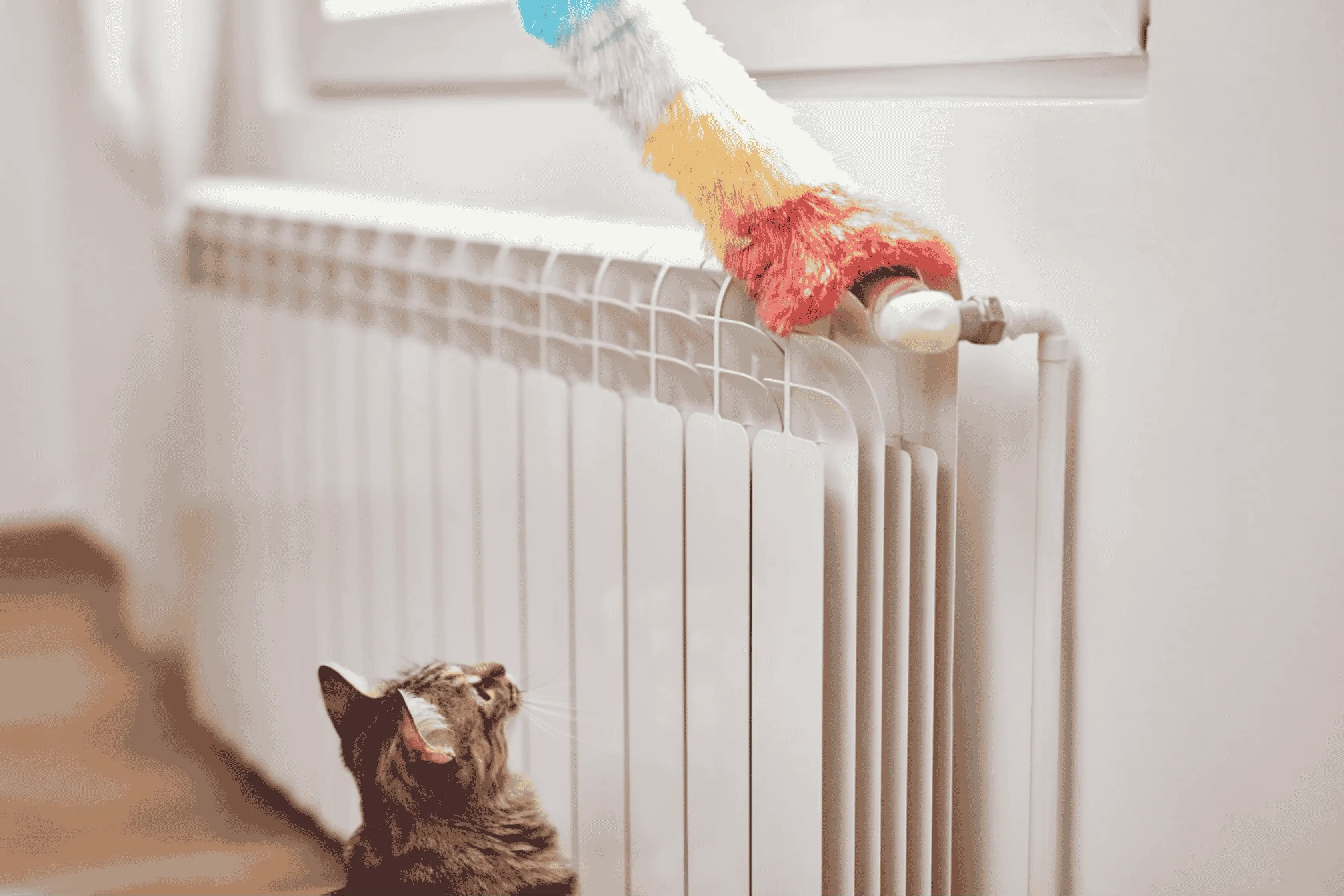In the UK, radiators are vital for creating a warm and inviting home during the winter season. However, they tend to collect dust and debris which can diminish their energy efficiency over time.
To help you keep your radiators in tiptop condition, inside and out, we’ve written this straightforward guide to cleaning radiators.
Cleaning dust from inside a radiator does not need any specialised equipment, in fact it is quite simple. There are 2 main ways to clean your radiator, one being removing all the dust and secondly is the best way to keep your radiators inside clean and flowing.
How To Clean Radiators Inside Through Flushing Your System!
Unsure how to clean the inside of a radiator? Well, here is a simple breakdown to how to flush your radiator system. Firstly, you need this equipment:
- Old towels or rags
- Spanner
- Hose pipe
- A radiator bleed key
- Bowl/bucket
Now you have the equipment you need, let's break down each step on how to clean the inside radiator without removing it off the wall.
1.Turn Heating Off
When working on your radiators, always turn off the heat and allow the radiators to cool before beginning. It usually takes approximately a half hour for them to completely cool down.
2.Cover Your Floors
Cover your floors with old sheets or towels to keep them clean while you remove the sludge and unclean water.
3. Turn Your Valves Off
Turn off the radiator's valves at both ends to disconnect it from the rest of your central heating system.
Turn off the TRV (thermostatic radiator valve) by hand, turning it clockwise or to the '0' position.
To turn off the lockshield valve, remove the plastic cover and use a spanner to turn it clockwise all the way.
4.Loosen TRV and Open The Bleed Valve
Use a spanner to unscrew the nut connecting the TRV to the radiator.Place a bucket beneath the TRV and use a radiator bleed key to open the bleed valve, removing any air pressure.
5.Drain The Radiator
Use your bucket to catch any sludge and foul water that pours from the valve. Then use your spanner to unscrew the nut on the lockshield valve and drain the water from that side of the radiator as well.
Drain the radiator and then close the bleed valve using your bleed key.
6. Take It Off The Wall
Once you’ve loosened the nuts on both valves, you can easily detach the radiator, but be sure to take it outside to flush it out, as it might still contain dirty water and sludge—cover the inlets with towels or plastic bags during transport to avoid a mess.
7.Flush The Radiator
Connect the hose to the radiator valve inlet, turn the tap on to flush out the sludge with clean water, gently tap the radiator with a rubber hammer if needed, ensure it's over a drain for cleanliness, and repeat the process at the other valve until the water runs clear
8.Reconnect the Radiator
Reattach the radiator to the wall, tighten the nuts, open both valves, ensure the lockshield valve is turned the same number of times as when you removed the radiator, and use the key to open the bleed valve, allowing trapped air to escape.
9. Check The Boiler Pressure
Seeing that you have disconnected your radiator previously you may need to top it back up!
As your heating is still not on, the boiler pressure should ideally be maintained within the range of 1 to 1.5 bar.
If the pressure falls below 1, it is necessary to utilize the external filling loop to restore the pressure.
You should now have a radiator that is free from sludge and thoroughly cleaned. Good job!

How To Clean Dust From Inside Radiators Properly!
Now you're ready to learn how to clean inside dusty radiators. Let's take a look at the simple step by step background on how to do it.
Step 1 - Turn Off Your Heating
First, switch off your heating and let the radiator cool down. Alongside being safer, this will prevent your radiator from sucking up more dust.
Step 2 - Vacuum or Dust The Inside
Next, use your hoover to clear as much dust as possible from and around the radiator. Cleaning the radiator fins can be challenging, but smaller vacuum pipes will come in handy.
Try to suck up any dust left behind, including underneath the radiator and where it meets the wall.
Step 3 - Grab A Microfibre Cloth
After you've cleared all the dust, place a cloth below your radiator and use a cleaning brush to push out any leftover debris.
You can use a professional radiator cleaning brush or make your own by wrapping a microfiber cloth around a piece of wood. Simply slide it into the radiator to remove any concealed dirt.
Step 4 - Rinse It Down
Next, fill a bucket with warm, soapy water. Wipe down the outside with a soft sponge (abrasive cleaners may harm the radiator's surface). Make sure your cloth is damp but not dripping, then clean it well.
As simple as that you know how to clean dust inside radiators in your home
Frequently Asked Questions
How To Clean Inside A Double Radiator?
Luckily it shouldn't be any different to a normal radiator, if you have the correct equipment everything should be all okay to clean.
How To Clean Old Radiators Inside?
Have you got a really older style radiator and fancy giving it a new lease of life? Here’s how you clean it:
- Step 1 - Ensure that your radiator is not heated.
- Step 2 - Employ your vacuum cleaner.
- Step 3 - Utilise your radiator brush.
- Step 4 - Vacuum again.
- Step 5 - Clean the wall (optional).
- Step 6 - Dry the wall (optional).
Can You Pour Water Down My Radiator To Clean It?
You can flush a radiator with ordinary water or with chemicals designed specifically to get it clean. Flushing also helps to remove dirt from the engine itself.
How To Clean Inside Radiator With Water Only?
Wipe down accessible areas of the radiator with warm, soapy water, then dry completely with a clean microfiber cloth to remove any lingering dust, ensuring no moisture remains to prevent rust.






















